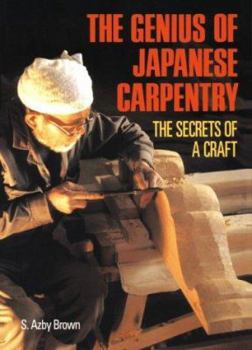The Genius of Japanese Carpentry: The Secrets of a Craft
0ver a thousand years ago in Nara, Japan, anonymous carpenters erected a number of temples and pagodas for a newly founded Buddhist monastery known as Yakushiji. Not only is one of those pagodas still standing today, but also surviving are the dedication to quality and the technical skill of its builders as seen in the work of modern-day craftsmen. The Genius of Japanese Carpentry focuses on such practicing carpenters, who combine in their work the...
Format:Paperback
Language:English
ISBN:4770019785
ISBN13:9784770019783
Release Date:September 1995
Publisher:Kodansha
Length:140 Pages
Weight:1.10 lbs.
Dimensions:0.6" x 10.1" x 7.2"
Customer Reviews
5 ratings
Major Insight into Japanese architecture through its unique building techniques!
Published by Thriftbooks.com User , 14 years ago
As a student of Japanese culture (spent three weeks in Japan attending a transcultural seminar), I finally decided I wanted to add a gazebo-like structure, similar to a "Japanese teahouse" to my Japanese garden in Vermont. After reading about the author's work in the New York Times, I purchased this book for help with understanding Japanese building techniques in the context of its historic architecture, specifically the grand religious temples of Ancient Japan. This book was most helpful in my project - giving proper reverence to the role of the Japanese carpenter - while explaining the importance of various joinery techniques achieved with carpentry tools unique to Japan. I would also like to note the excellent illustrations of Japanese tools that are little known outside of Japan, and a wonderful picture of the Master Carpenter in his workshop with his tools in the background. ***Lark
Mindblowing!
Published by Thriftbooks.com User , 14 years ago
Not sure why people gave some harsh reviews of this incredible book? The book is centered around the restoration of Yakushiji shrine in Nara, with the original grandeur expected to be complete in 2030. I do not agree that it is a beginners book, and it is not exactly a how-to book because this art can only be taught from master to apprentice; learning it from a book would be impossible. Further, it states in the intro that it is not a "how-to" book, but is rather an on-the-scenes account of the project; a mission the book excels at. The book explains all the basic techniques that go into this style of construction, from design, to wood selection, to the tools and joinery. It is filled with great b/w photos and diagrams of the architectural design and follows the story as a group of builders recreate an authentic reproduction of the "Picture Hall" in the Sanzo-in sub-compound from 1985-88. On this journey the book aptly demonstrates the intricate process and does so in a way that is easy to understand even though it is next to impossible for anyone not trained in this art to do. The book also tells the story of the fascinating master-builder Nishioka (born 1908) who was contracted for the project, and the author's experience as an apprentice in Japan learning this art. An amazing feature of Japanese temple architecture that Nishioka adhered to is the selection of trees. Giant Hinoki are selected according to orientation, so for example a tree on the north side of a mountain is marked, and the northern exposed side of the wood is used on the north facing side of the temple. I don't think westerners ever dreamed of this concept. One of Nishioka's first projects involved restoration work on Horyuji shrine. Built some 1300 years ago, Nishioka determined the original wood construction was good for another 2000 years! Amazing. If you are unfamiliar with Yakushiji, it is a 1,300 year old Buddhist monastery (built 718). It offered a stunning recurrence of the symetrical composition of the Chinese prototypes, including 2 32-meter pagodas. This is one of my favorite books on traditional Japanese architecture, and I highly recommend it.
Excellent book on Japanese architecture
Published by Thriftbooks.com User , 18 years ago
This book presents an excellent detailed view of the entire restoration process of the picture hall which is part of Yakushiji temple. I have been marvelled at the bracket (tou-kung) structures in ancient Chinese and Japanese temples but I was not able to find much information about them anywhere. This book not only describes in detail how the bracket system holds the weight of the roof, but also how they are constructed, with detail photos and diagrams of many mortise/tenon joints. In short, it is just an incredible book that gives you insights into how those Japanese temples were built, without a single piece of nail that holds them together, but yet lasted for centuries.
Fascinating book
Published by Thriftbooks.com User , 22 years ago
Did you know that wood from trees that were growing on the south-facing side of a mountain has got to be used in the southern-facing face of a Japanese temple, so that it experiences the same weather conditions as it used to and doesn't warp so much? Or that the curving grain of a wood can be used to support a load from above, so the curve neutralises the sagging? This and many other fascinating aspects of the highly refined art of Japanese carpentry are revealed in this book. Every page makes you marvel at its precision, sophistication and sheer ingenuity. Azby Brown writes with clarity and knows how to capture all the interesting details.
Overview of Japanese Joinery in Carpentry and Architecture
Published by Thriftbooks.com User , 26 years ago
A high-level look at Japanese joinery in carpentry and temple architecture. Good photographs and diagrams. This book would have more meaning to a carpenter as it is not an instruction book to learning and implementing these techniques.




